VOLVO XC90 TWIN ENGINE HYBRID 2017 Owners Manual
Manufacturer: VOLVO, Model Year: 2017, Model line: XC90 TWIN ENGINE HYBRID, Model: VOLVO XC90 TWIN ENGINE HYBRID 2017Pages: 584, PDF Size: 14.2 MB
Page 541 of 584
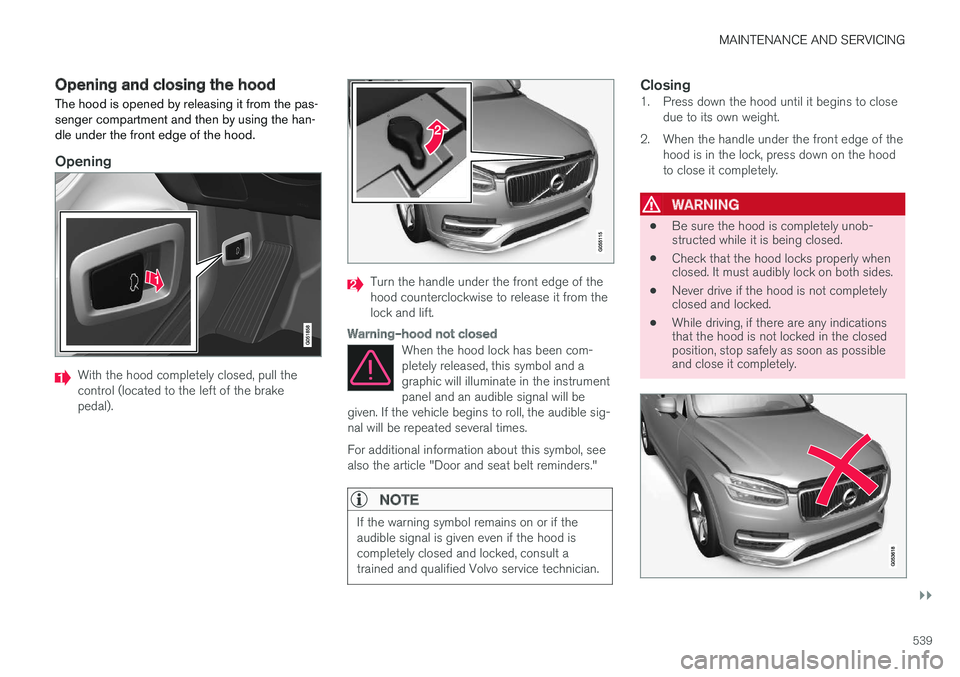
MAINTENANCE AND SERVICING
}}
539
Opening and closing the hood
The hood is opened by releasing it from the pas-senger compartment and then by using the han-dle under the front edge of the hood.
Opening
With the hood completely closed, pull thecontrol (located to the left of the brakepedal).
Turn the handle under the front edge of thehood counterclockwise to release it from thelock and lift.
Warning–hood not closed
When the hood lock has been com-pletely released, this symbol and agraphic will illuminate in the instrumentpanel and an audible signal will begiven. If the vehicle begins to roll, the audible sig-nal will be repeated several times.
For additional information about this symbol, seealso the article "Door and seat belt reminders."
NOTE
If the warning symbol remains on or if theaudible signal is given even if the hood iscompletely closed and locked, consult atrained and qualified Volvo service technician.
Closing
1. Press down the hood until it begins to closedue to its own weight.
2. When the handle under the front edge of thehood is in the lock, press down on the hoodto close it completely.
WARNING
•Be sure the hood is completely unob-structed while it is being closed.
•Check that the hood locks properly whenclosed. It must audibly lock on both sides.
•Never drive if the hood is not completelyclosed and locked.
•While driving, if there are any indicationsthat the hood is not locked in the closedposition, stop safely as soon as possibleand close it completely.
Page 542 of 584

||
MAINTENANCE AND SERVICING
540
Hood completely closed
Related information
•Engine compartment overview (p. 540)
•Door and seat belt reminders (p. 70)
Engine compartment overview
The engine compartment overview shows somemaintenance points.
Some of the components in the vehicle's electri-cal drive system are located in the engine com-partment.
WARNING
•Orange cables should only be handled bya trained and qualified Volvo service tech-nician.
•A number of the vehicle's componentsuse high voltage and can be very danger-ous if handled improperly.
•Do not touch any components that havenot been clearly described/explained inthis manual.
•Use caution when checking/refilling flu-ids in the engine compartment.
•The cooling fan (located at the front ofthe engine compartment, behind the radi-ator) may start or continue to operate (forup to 6 minutes) after the engine hasbeen switched off.
•Engine cleaning should only be done by aworkshop. If engine cleaning agents areused when the engine has been running,there may a fire risk.
•Before performing any operations in theengine compartment, the ignition shouldalways be completely switched off (inmode 0) and there should be no remotekeys in the passenger compartment. Thegear selector should be in the P (park)position. If the engine has been running,wait until it has cooled before touchingany components in the engine compart-ment.
•The distributor ignition system operatesat very high voltages. Special safety pre-
Page 543 of 584
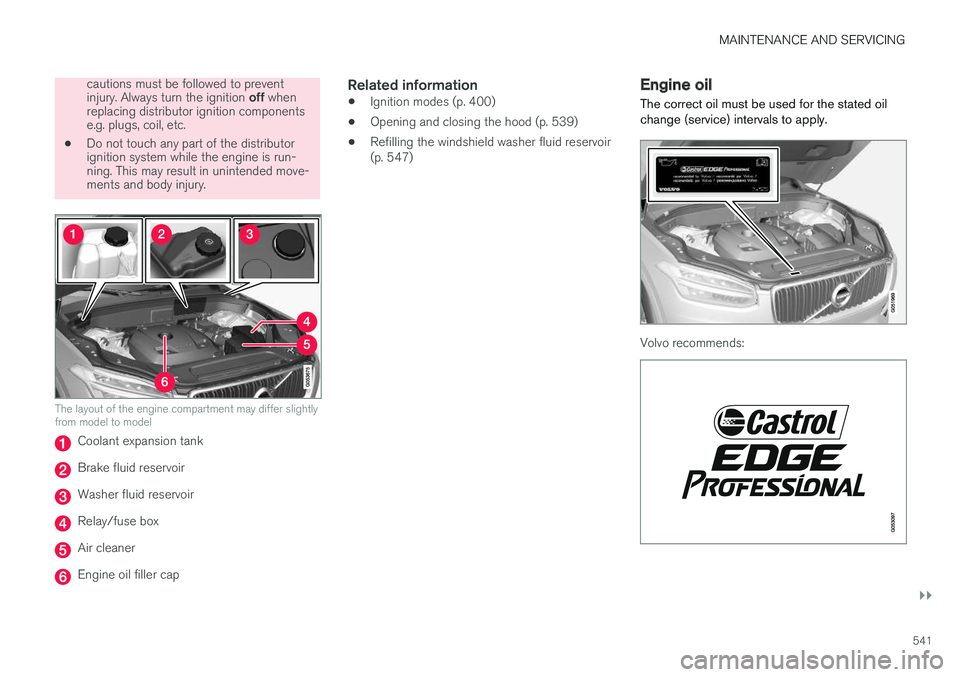
MAINTENANCE AND SERVICING
}}
541
cautions must be followed to preventinjury. Always turn the ignition off whenreplacing distributor ignition componentse.g. plugs, coil, etc.
•Do not touch any part of the distributorignition system while the engine is run-ning. This may result in unintended move-ments and body injury.
The layout of the engine compartment may differ slightlyfrom model to model
Coolant expansion tank
Brake fluid reservoir
Washer fluid reservoir
Relay/fuse box
Air cleaner
Engine oil filler cap
Related information
•Ignition modes (p. 400)
•Opening and closing the hood (p. 539)
•Refilling the windshield washer fluid reservoir(p. 547)
Engine oil
The correct oil must be used for the stated oilchange (service) intervals to apply.
Volvo recommends:
Page 544 of 584
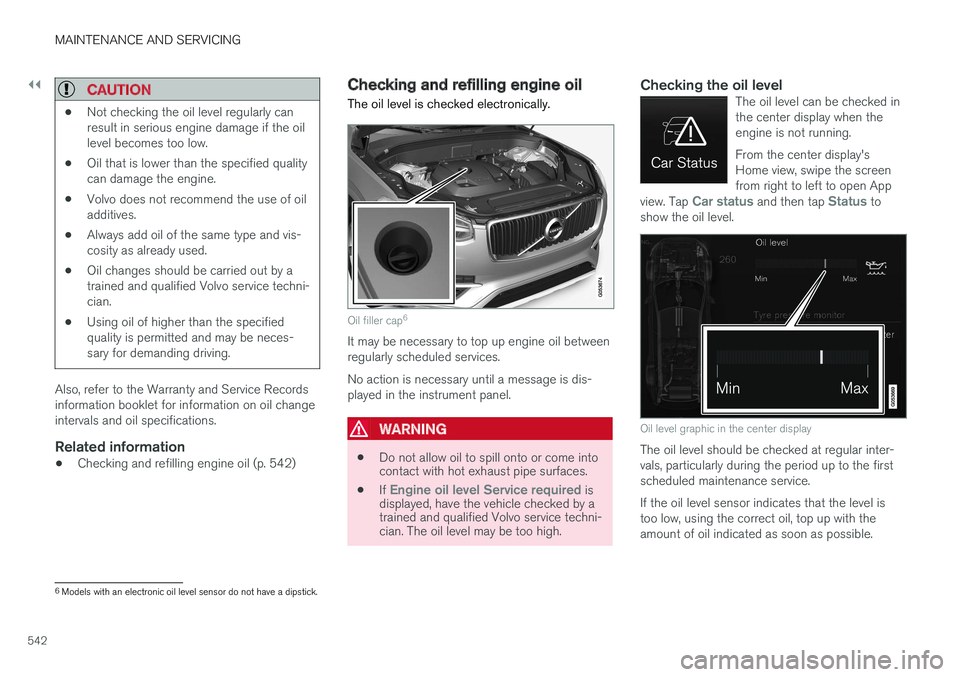
||
MAINTENANCE AND SERVICING
542
CAUTION
•Not checking the oil level regularly canresult in serious engine damage if the oillevel becomes too low.
•Oil that is lower than the specified qualitycan damage the engine.
•Volvo does not recommend the use of oiladditives.
•Always add oil of the same type and vis-cosity as already used.
•Oil changes should be carried out by atrained and qualified Volvo service techni-cian.
•Using oil of higher than the specifiedquality is permitted and may be neces-sary for demanding driving.
Also, refer to the Warranty and Service Recordsinformation booklet for information on oil changeintervals and oil specifications.
Related information
•Checking and refilling engine oil (p. 542)
Checking and refilling engine oil
The oil level is checked electronically.
Oil filler cap6
It may be necessary to top up engine oil betweenregularly scheduled services.
No action is necessary until a message is dis-played in the instrument panel.
WARNING
•Do not allow oil to spill onto or come intocontact with hot exhaust pipe surfaces.
•If Engine oil level Service required isdisplayed, have the vehicle checked by atrained and qualified Volvo service techni-cian. The oil level may be too high.
Checking the oil level
The oil level can be checked inthe center display when theengine is not running.
From the center display'sHome view, swipe the screenfrom right to left to open Appview. Tap Car status and then tap Status toshow the oil level.
Oil level graphic in the center display
The oil level should be checked at regular inter-vals, particularly during the period up to the firstscheduled maintenance service.
If the oil level sensor indicates that the level istoo low, using the correct oil, top up with theamount of oil indicated as soon as possible.
6Models with an electronic oil level sensor do not have a dipstick.
Page 545 of 584
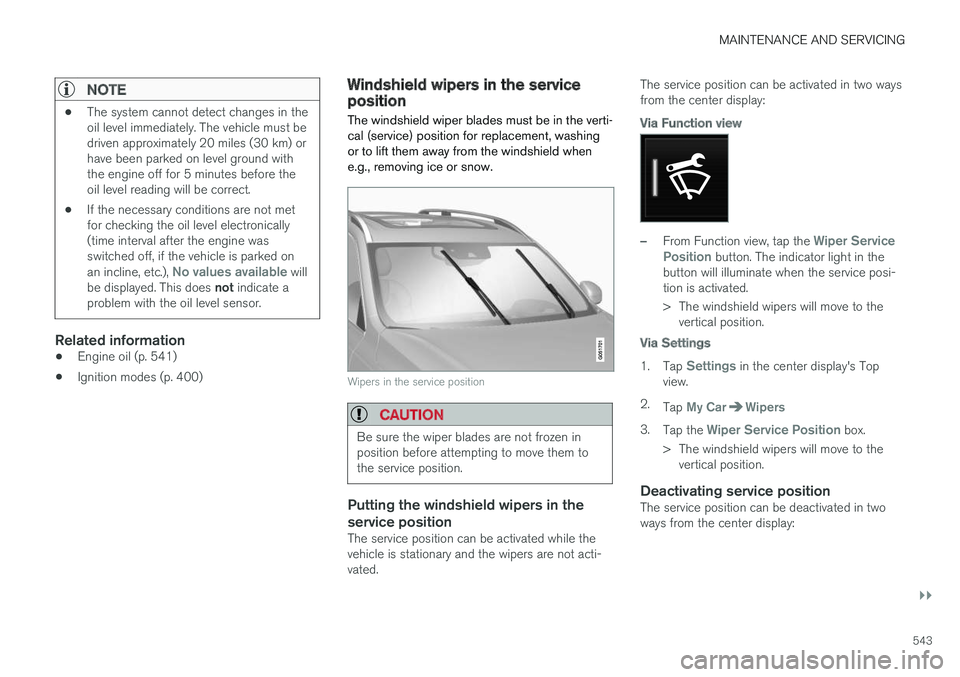
MAINTENANCE AND SERVICING
}}
543
NOTE
•The system cannot detect changes in theoil level immediately. The vehicle must bedriven approximately 20 miles (30 km) orhave been parked on level ground withthe engine off for 5 minutes before theoil level reading will be correct.
•If the necessary conditions are not metfor checking the oil level electronically(time interval after the engine wasswitched off, if the vehicle is parked onan incline, etc.), No values available willbe displayed. This does not indicate aproblem with the oil level sensor.
Related information
•Engine oil (p. 541)
•Ignition modes (p. 400)
Windshield wipers in the serviceposition
The windshield wiper blades must be in the verti-cal (service) position for replacement, washingor to lift them away from the windshield whene.g., removing ice or snow.
Wipers in the service position
CAUTION
Be sure the wiper blades are not frozen inposition before attempting to move them tothe service position.
Putting the windshield wipers in the
service position
The service position can be activated while thevehicle is stationary and the wipers are not acti-vated.
The service position can be activated in two waysfrom the center display:
Via Function view
–From Function view, tap the Wiper ServicePosition button. The indicator light in thebutton will illuminate when the service posi-tion is activated.
>The windshield wipers will move to thevertical position.
Via Settings
1.Tap Settings in the center display's Topview.
2.Tap My CarWipers
3.Tap the Wiper Service Position box.
>The windshield wipers will move to thevertical position.
Deactivating service position
The service position can be deactivated in twoways from the center display:
Page 546 of 584

||
MAINTENANCE AND SERVICING
544
Via Function view
–From Function view, tap the Wiper ServicePosition button. The indicator light in thebutton will go out when the service positionis deactivated.
Via Settings
1.Tap Settings in the center display's Topview.
2.My CarWipers
3.Tap the Wiper Service Position to deselectthe box.
The wipers will also leave the service position if:
•The wipers are activated.
•The windshield washers are activated.
•The rain sensor is activated.
CAUTION
If the wiper arms have been folded out fromthe windshield while in the service position,fold them back against the windshield beforereturning the wipers to the normal position tohelp avoid scratching the paint on the hood.
Related information
•Replacing wiper blades (p. 544)
•Using the windshield wipers (p. 161)
Replacing wiper blades
The wiper blades should be replaced regularlyfor best effect.
The windshield wiper blades must be in the verti-cal (service) position for replacement, washingor to lift them away from the windshield whene.g., removing ice or snow.
Replacing the windshield wiper blades
Page 547 of 584
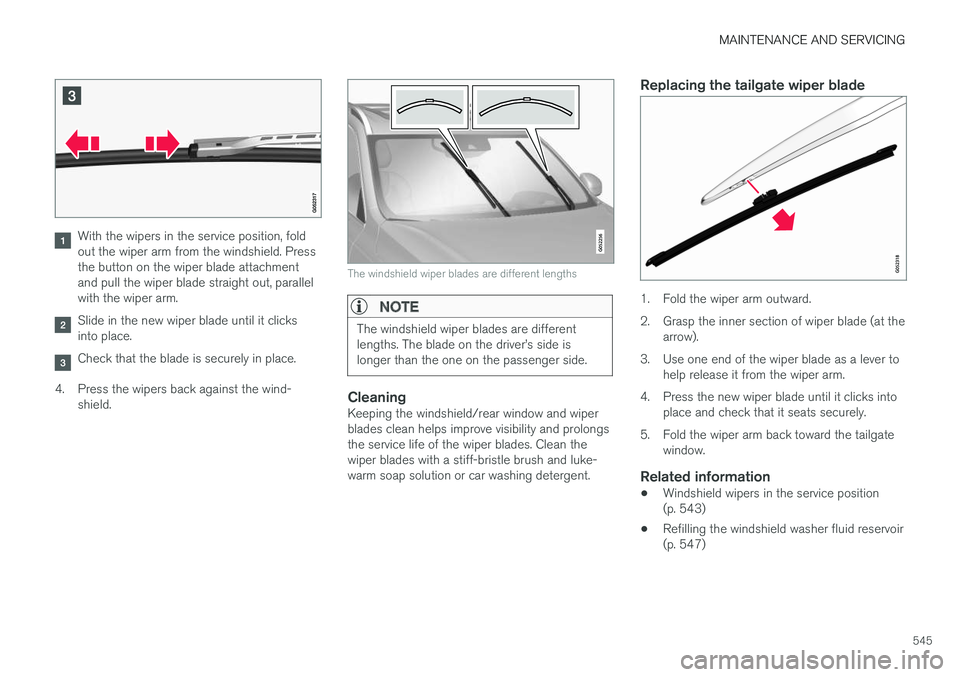
MAINTENANCE AND SERVICING
545
With the wipers in the service position, foldout the wiper arm from the windshield. Pressthe button on the wiper blade attachmentand pull the wiper blade straight out, parallelwith the wiper arm.
Slide in the new wiper blade until it clicksinto place.
Check that the blade is securely in place.
4.Press the wipers back against the wind-shield.
The windshield wiper blades are different lengths
NOTE
The windshield wiper blades are differentlengths. The blade on the driver
Page 548 of 584
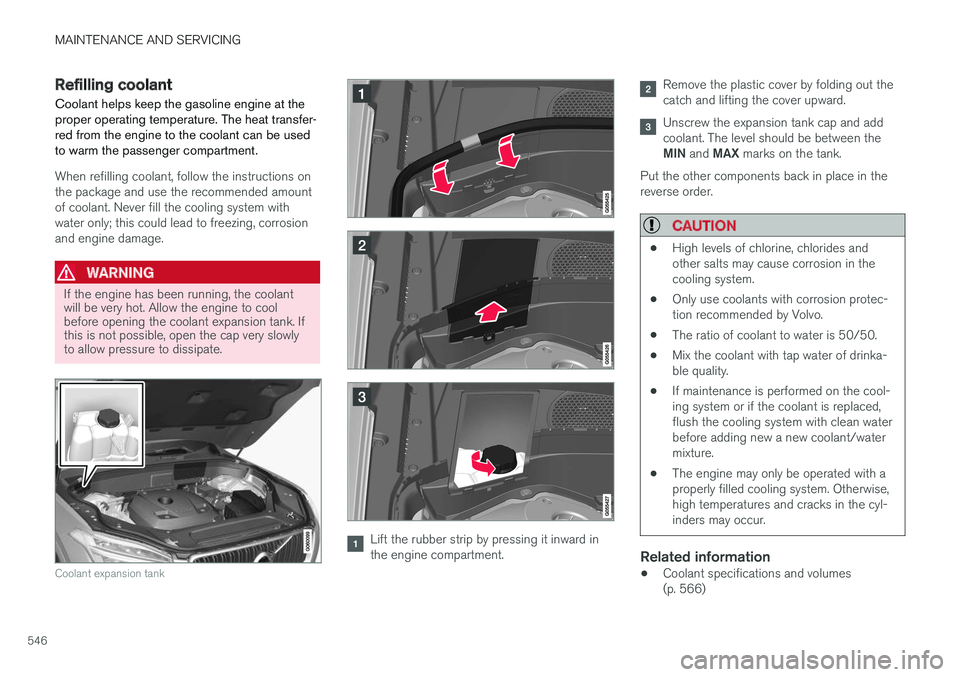
MAINTENANCE AND SERVICING
546
Refilling coolant
Coolant helps keep the gasoline engine at theproper operating temperature. The heat transfer-red from the engine to the coolant can be usedto warm the passenger compartment.
When refilling coolant, follow the instructions onthe package and use the recommended amountof coolant. Never fill the cooling system withwater only; this could lead to freezing, corrosionand engine damage.
WARNING
If the engine has been running, the coolantwill be very hot. Allow the engine to coolbefore opening the coolant expansion tank. Ifthis is not possible, open the cap very slowlyto allow pressure to dissipate.
Coolant expansion tank
Lift the rubber strip by pressing it inward inthe engine compartment.
Remove the plastic cover by folding out thecatch and lifting the cover upward.
Unscrew the expansion tank cap and addcoolant. The level should be between theMIN and MAX marks on the tank.
Put the other components back in place in thereverse order.
CAUTION
•High levels of chlorine, chlorides andother salts may cause corrosion in thecooling system.
•Only use coolants with corrosion protec-tion recommended by Volvo.
•The ratio of coolant to water is 50/50.
•Mix the coolant with tap water of drinka-ble quality.
•If maintenance is performed on the cool-ing system or if the coolant is replaced,flush the cooling system with clean waterbefore adding new a new coolant/watermixture.
•The engine may only be operated with aproperly filled cooling system. Otherwise,high temperatures and cracks in the cyl-inders may occur.
Related information
•Coolant specifications and volumes(p. 566)
Page 549 of 584

MAINTENANCE AND SERVICING
}}
* Option/accessory, for more information, see Introduction.547
Refilling the windshield washer fluidreservoir
Washer fluid helps keep the windshield andheadlights clean.
The windshield and headlight washers* share acommon reservoir. Open the blue cap to refillwasher fluid (see the illustration for the locationof the reservoir).
During cold weather, the reservoir should be filledwith windshield washer solvent containing anti-freeze. Use Volvo Original Washer Fluid or theequivalent with a recommended pH valuebetween 6 and 8 in a 1:1 solution.
When there is approx. 1 qt (1 liter) of washerfluid remaining in the reservoir, a text message
and the symbol will be displayed in theinstrument panel.
Related information
•Opening and closing the hood (p. 539)
•Engine compartment overview (p. 540)
Cleaning the exterior
The vehicle should be washed at regular inter-vals since dirt, dust, insects and tar spotsadhere to the paint and may cause damage. Tohelp prevent corrosion, it is particularly importantto wash the car frequently in the wintertime.
Hand washing
The following points should be kept in mind whenwashing and cleaning the car:
CAUTION
Avoid using car washing detergents with a pHvalue lower than 3.5 or higher than 11.5.Doing so could result in discoloring of ano-dized aluminum surfaces on e.g., roof rails orthe frames around the side windows.
•Avoid washing your car in direct sunlight.Doing so may cause detergents and wax todry out and become abrasive. To avoidscratching, use lukewarm water to soften thedirt before you wash with a soft sponge, andplenty of sudsy water.
•Bird droppings: Remove from paintwork assoon as possible. Otherwise the finish maybe permanently damaged.
•A car washing detergent can be used tofacilitate the softening of dirt and oil.
Page 550 of 584
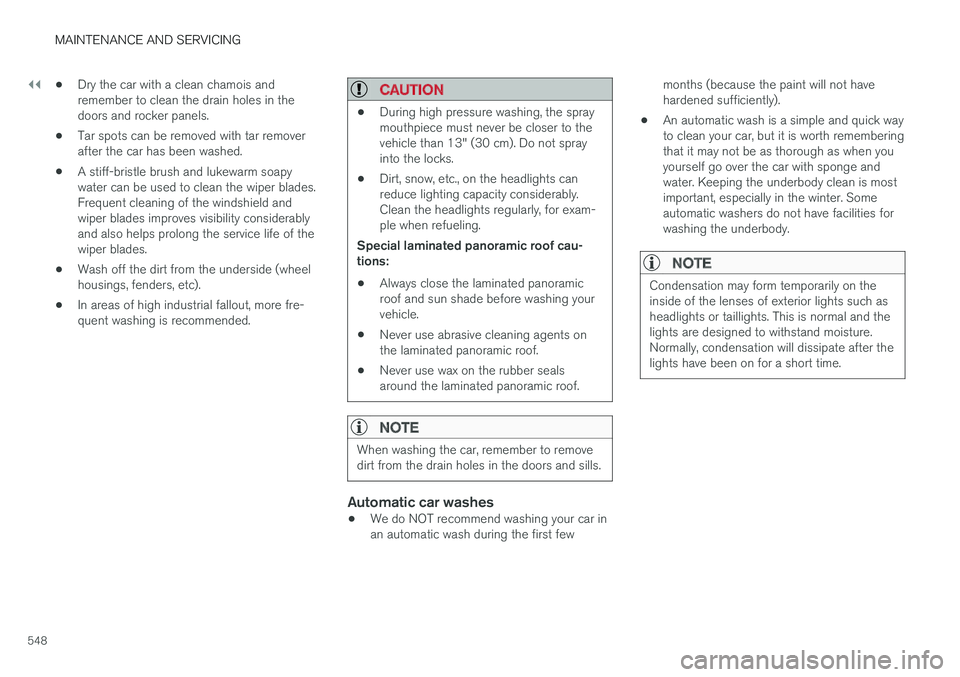
||
MAINTENANCE AND SERVICING
548
•Dry the car with a clean chamois andremember to clean the drain holes in thedoors and rocker panels.
•Tar spots can be removed with tar removerafter the car has been washed.
•A stiff-bristle brush and lukewarm soapywater can be used to clean the wiper blades.Frequent cleaning of the windshield andwiper blades improves visibility considerablyand also helps prolong the service life of thewiper blades.
•Wash off the dirt from the underside (wheelhousings, fenders, etc).
•In areas of high industrial fallout, more fre-quent washing is recommended.
CAUTION
•During high pressure washing, the spraymouthpiece must never be closer to thevehicle than 13" (30 cm). Do not sprayinto the locks.
•Dirt, snow, etc., on the headlights canreduce lighting capacity considerably.Clean the headlights regularly, for exam-ple when refueling.
Special laminated panoramic roof cau-tions:
•Always close the laminated panoramicroof and sun shade before washing yourvehicle.
•Never use abrasive cleaning agents onthe laminated panoramic roof.
•Never use wax on the rubber sealsaround the laminated panoramic roof.
NOTE
When washing the car, remember to removedirt from the drain holes in the doors and sills.
Automatic car washes
•We do NOT recommend washing your car inan automatic wash during the first few
months (because the paint will not havehardened sufficiently).
•An automatic wash is a simple and quick wayto clean your car, but it is worth rememberingthat it may not be as thorough as when youyourself go over the car with sponge andwater. Keeping the underbody clean is mostimportant, especially in the winter. Someautomatic washers do not have facilities forwashing the underbody.
NOTE
Condensation may form temporarily on theinside of the lenses of exterior lights such asheadlights or taillights. This is normal and thelights are designed to withstand moisture.Normally, condensation will dissipate after thelights have been on for a short time.